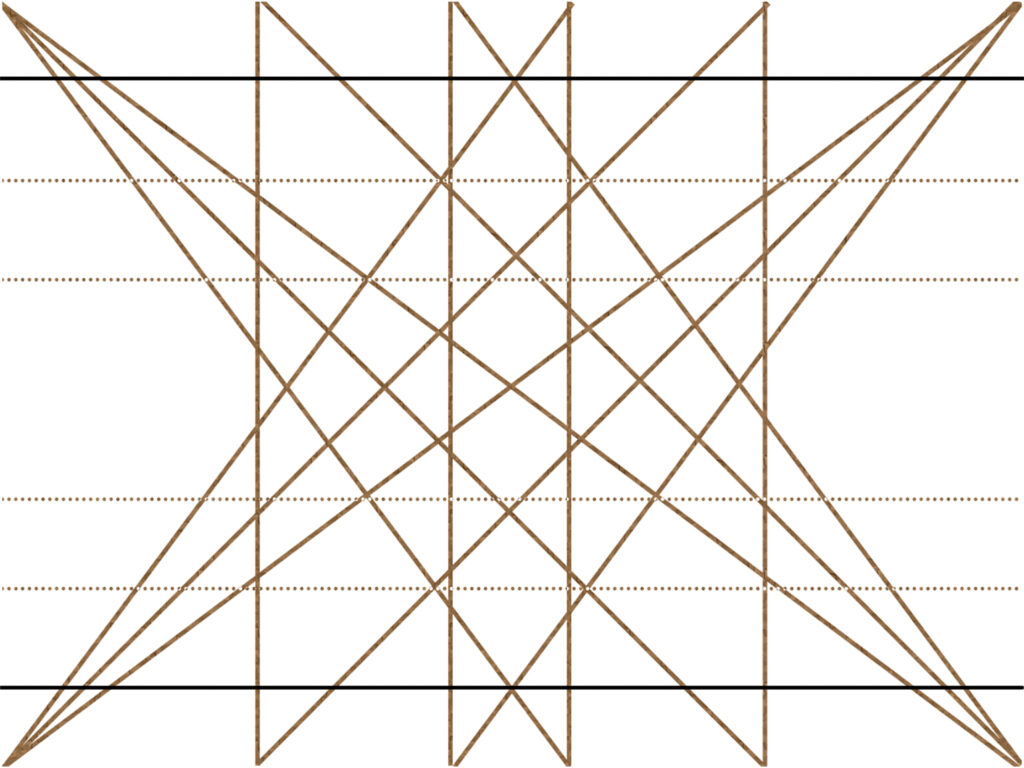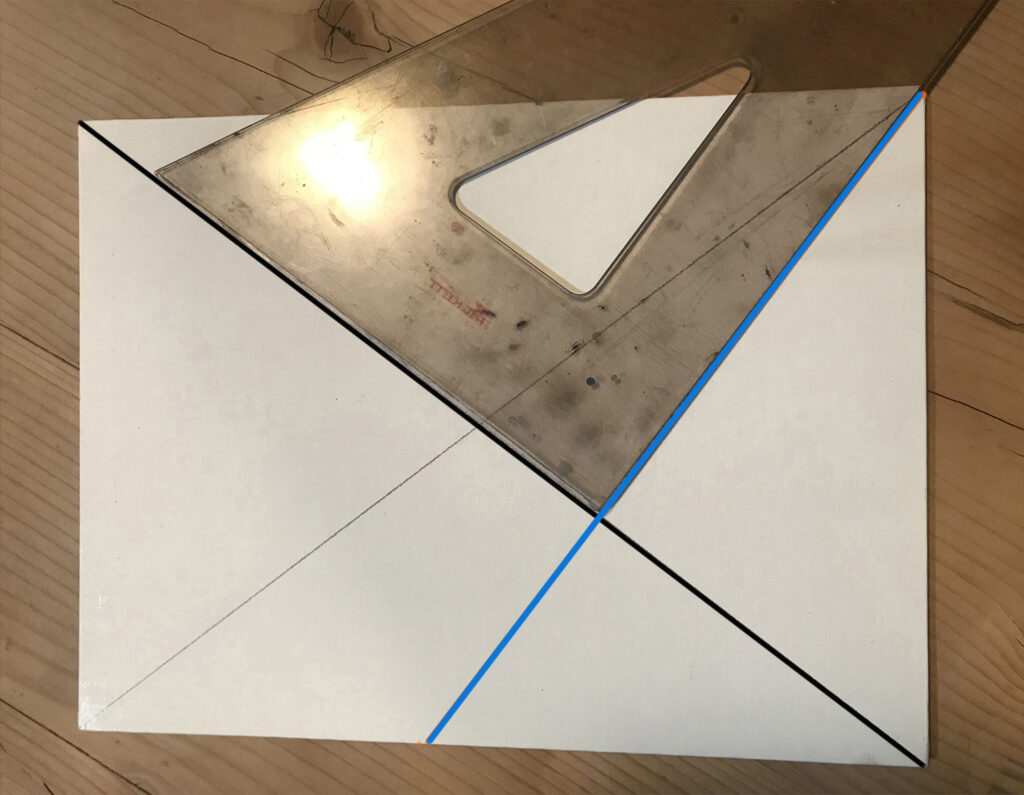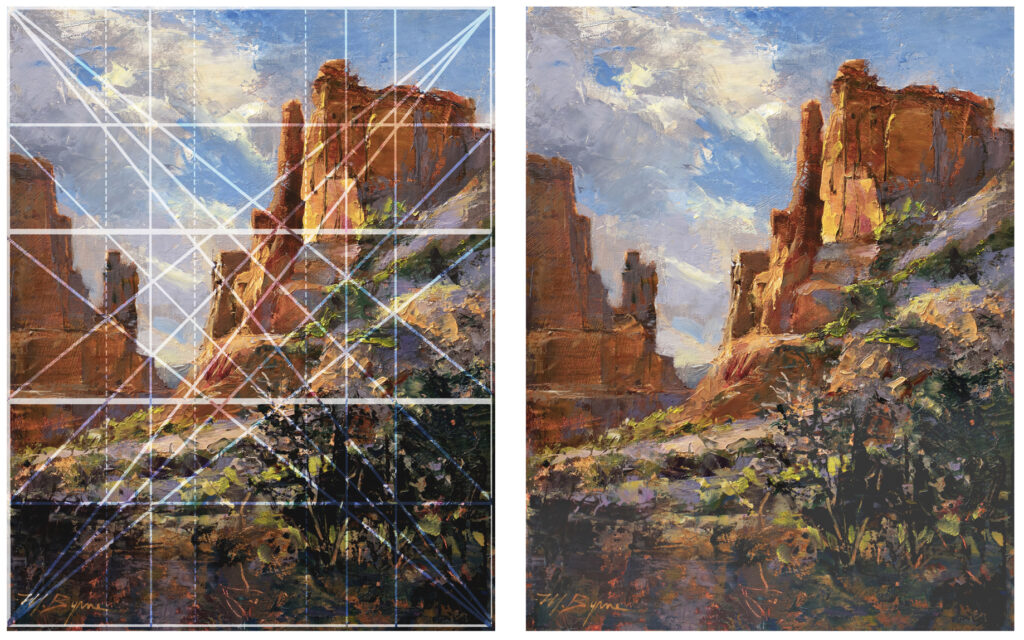We’ve all heard of the Golden Section, Dynamic Symmetry, the rule of thirds and harmonic armatures. And we’ve always been told to do a value study before we start a painting. However, in our rush to get started painting, many of us disregard it all and jump right in to putting brush to canvas.
Six years ago, I made a pledge to NEVER skip a value study before plein air painting. Soon after, I learned how to design my pieces with a “thrust map” as well. This is a simple 2” study done on a 4”x6” index card with pencil or markers. I indicate the Dominant Vertical (DV), Dominant Horizontal (DH) and Dominant Diagonal (DD). Ideally where all of these lines meet will be my focal point.


Around the same time, I started studying Dynamic Symmetry with Victor Vargas of the Academy of Composition near Reading, PA. I studied with him for six months.
I had heard of the Golden Rectangle, and knew about the Golden Spiral, but I never learned WHY they were important. I received a BFA from Kutztown University in graphic design, and studied at PAFA, and never did a professor do more than mention them in passing.
DYNAMIC SYMMETRY AND THE FIBONACCI NUMBERS
After studying with Victor, I started using Root Rectangles, which I will explain later, and an underlying grid system.
In 2016 at the RMPAP event in Jackson, Wyoming, I painted the piece below using the new knowledge I had gained. During the opening event I received numerous satisfying comments from notable artists along the line of “I love the design of your piece”! They were comments I had not heard before. The piece also won an Award of Excellence. I was THRILLED and encouraged to delve more into this system of design.

2016, 18″ x 14″ – Oil
Directional lines pointing to focal point to move the viewer’s eye around the canvas
FIBONACCI SEQUENCE
I learned about the Fibonacci sequence and how it relates to the Golden Ratio. I am NOT a mathematician and could not relate to the algebra, but I was intrigued by the history of it, dating back thousands of years to Greek vase design and the Egyptian Pyramids. Visually, I understand the idea.

This sequence shows up constantly in nature. The number of petals on flowers are a Fibonacci number. The proportion of our bodies are in this ratio. For example, both the distance from our shoulder to our elbow, and the distance from elbow to tip of index finger is a ratio of 1 – 1.6.
Michelangelo was said to have been obsessed with the spiral and used it in designing his paintings in the Sistine Chapel. Vincent Van Gogh wrote a letter to his brother Theo mentioning the simple grid system he used to design his paintings. He said he could paint with lightning speed once he had the design down.

Root rectangles are made from the Fibonacci sequence to form the basic rectangles shown above.
The problem with using Root Rectangles in our artwork is that they are not used in today’s standard size canvases and frames. Why not? It’s a controversial subject and you can read endless articles on the internet.
In today’s world neither movie screens, iPhones, televisions computer screens, etc. are using Root rectangles. (Perhaps we have become too out of tune with nature?) Only a few standard sizes fall into root rectangles and they are shown below.
5×7 – Root 2
8×10
9×12
12×16
11×14 – Root Phi
12×24 – Root 4
16×20
18×24
24×36
For some of my larger studio work, I use root rectangle-sized canvases and have custom 22K gold gilt frames made for them. However, for quick plein air paintings and studies, I do not want to cut my own panels or order custom frames. Therefore, I decided to adjust the grid system to standard sizes for plein air painting. After learning how to design the grid, I adapted it to 8” x 10, 9” x 12” and any other size I chose to use.
DESIGNING THE GRID
The only tools you need are a pencil, ruler and T-square or triangle. It seems complicated at first, but after a while, it will come more easily. You can adapt this grid to any size. Below is the grid for 9 x 12, 12 x 16, 18 x 24, etc.

For the first time this year, I taught back-to-back workshops at the Booth Art Academy (GA) and the Center for the Arts in Bonita Springs (FL). I decided to attempt to teach this grid system because so many artists were inquiring about my grids shown on social media. Each class was full with 15 students and most were having a hard time understanding the process. When class was over, I asked them to vote if they would have preferred the class with or without the grids taking up a lot of their time. The grid system had not been on the class description. Every single student said they loved learning this new system and were anxious to try it out on their own!

While at the Booth Western Art Museum, I gave a PowerPoint presentation on how I use this system in my work. The presentation, which goes into more depth about gridwork and thrust maps, is available to view on the Booth Facebook page or on my YouTube channel which you can find at this link: https://www.youtube.com/watch?v=HPV4cDXFzoI&t=746s
EXAMPLES OF PIECES CREATED USING THIS SYSTEM
Shown below is a plein air painting I did this past September in Arches National Park near Moab, Utah.
(The rough value study is pictured at the beginning of this blog article.) There was a grid drawn on the 14” x 11” (root phi) panel before I started. The grid helps with placement. After I establish the placement in the under painting, I am free to let loose and have fun.

Arches Morning Light by Michele Byrne
14” x 11” – Oil, Root Phi Grid
The grid above is placed over the painting to illustrate my thought process.
“Sunlit Street of Rome” – 12” x 9” was painted as a demo during an online Zoom class I taught last year. The much more detailed value study shown above (at the beginning of this article) was done to show the students exactly what I had in mind for the piece before I started.
The grid is a great help when painting the underpainting in my studio practice. It also helps when drawing complex scenes like cityscapes.
This piece won the IMPRESSIONIST AWARD at the OPA Salon Show last year.

12” x 9” – oil on panel using my own altered grid
You may think this is a lot of unnecessary work, too complicated and not for you. I probably would have thought the same thing 10 years ago.
It’s a few extra steps in the beginning I must admit. However, I draw the grids on my standard-sized panels the night before painting. Having a grid helps me decide the placement of compositional elements such as the horizon line or mountain. In cityscapes, a grid helps me decide where to put the vertical side of a building, or where to place the figure. For me it sets a starting point. Once I start passionately painting in the thick juicy paint, the grid disappears. Only I know It was ever there. I’ve used the grid so long now that even when I don’t have a grid on the canvas, I can still visualize exactly where it would be.
Understanding the Fibonacci Sequence and root rectangles, and using the grid system has strengthened the design of my paintings, which my collectors and galleries appreciate. And I love sharing this knowledge with students so they can produce stronger work as well.

Christine Lashley says
Really excellent info my friend!
Michele Byrne says
Thanks so much Christine!!
Dan Knepper says
Great article!
Michele Byrne says
Thank You Daniel – so happy to hear you enjoyed it!
Dot Bunn says
Studied Dynamic Symmetry with Myron Barnstone years ago and I use it regularly in my studio practice. Very helpful for achieving good composition.
Michele says
Hi Dot! I remember you had told me that years ago… I admire your color palette as well!
Trish Savides says
I learned of the Golden Ratio in 1999 from the late artist and author Frank Covino in a workshop. He opened his weeklong workshop with this.
I was mesmerized by it and truly believe this is the universal compositional tool for artists. I always incorporate it in every painting. Thank you for writing this article!
Sincerely,
Trish Savides
Michele says
Thank You Trish! Thanks for your comment… and I’m happy you agree… there’s such an amazing history to it all.
Trish savides says
no question about it’s Truth!
Ceci Neustrom says
Thanks so much for that wonderful info…I’ve been reading up on these concepts for the last couple years…am very intrigued by it all….but as of yet haven’t started incorporating it into my work. Your article may well get me there!
Michele Byrne says
Thanks for reading the blog Ceci! I hope it inspires you add this to your painting practice : )
Vicky Ramsay says
Fascinating…would love to know more. I see it in your work now that you have pointed it out…Thank you for sharing:)
Michele Byrne says
Thank you Vicky! Google Dynamic Symmetry and you will find lots to read about it… there’s tons of info on YouTube.
M Kathryn Massey, OPA says
I am reminded of something Albert Einstein spoke:
“Knowledge is limited. Imagination encircles the world,”
M Kathryn Massey, OPA says
I am reminded of something Albert Einstein said:
“Knowledge is limited. Imagination encircles the world.”
Michele Byrne says
Great quote – thanks for sharing!
Rick Lewis says
Great info. Maybe you could do a video with the theory and practical application of it in your work. Would love to see that.
Michele Byrne says
Hi Rick. I am having an online workshop the next two weekends. Saturday mornings – 3 hours each.
April 23 & 30th.
You can read more about it on my website:
https://www.michelebyrne.com/workshops
Michele Byrne says
Thanks for your comment Rick! I did a presentation with the Booth Museum that’s on my YouTube channel that goes a bit farther into detail… also teaching an online workshop on it on April 23.
https://www.youtube.com/channel/UCv1ZFnaEkW_mWUtLqE8_eBQ?view_as=subscriber
https://www.michelebyrne.com/workshops
KarenCooper says
Wow. Watched all that, head still spinning 🙂
Will there be an inperson workshop coming, geared toward using the concept as the root of the painting?
Michele Byrne says
Hi Karen, Thanks for your comment. I’ll be covering it in in my class in Santa Fe in August
Theresa Grillo Laird says
Fantastic article! Thank you!
Michele Byrne says
Thanks so much Theresa!!
Cynthia Rosen says
Fabulous article, Michele! I have heard of some painters who teach but don’t really share their ‘finer tricks of the trade. It is always great to see a painter who is so giving. Bravo to you for giving a great gift to so many.
Michele Byrne says
Thanks Cynthia! I believe there are enough patrons out there to keep us all in business. I enjoy sharing my knowledge with others. So many artists/teachers have given so much to me – I like to pay it forward.
Karen Storm says
I just now got the opportunity to read your post. This is fantastic! Coming from architecture. I have had exposure to these concepts, but I want to learn how to incorporate them into my art work. No wonder my paintings have no bones.
Michele Byrne says
Thank so much Karen – I’m happy to hear you enjoyed the article. I’m actually teaching an online workshop this Sat. April 23 – 3 hours on Zoom,
You can read about it on my website,
Let me know if you have any questions:
https://www.michelebyrne.com/workshops
Tina Swindell says
I have to learn to incorporate this. I do to some extent but your article inspires me to dig deeper. Thank you!
Michele Byrne says
Thank you Tina!
I’m teaching an online workshop the next two weekends.
April 23 & 30 – 3 hours each.
You can read more about it on my website:
If you cannot make those dates you can watch the recorded version after you sign up.
https://www.michelebyrne.com/workshops
Lori McNee says
Michele, I just happened upon your excellent article! Thank you 😊
Richard Farmer says
Read”Painting for Beginners “ by Jan Gordon.
Myron should have known about this book. This is where I Iearned that the European artist uses the straight line and geometry more than a USA artist.
There is no art unless there is math.
I truly believe the system is valid .
Become familiar with the “sinister diagonal and Baroque diagonal as it applies to a Golden Rectangle.
Sincerely,
Dick Farmer